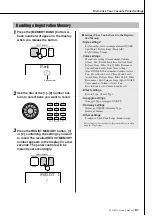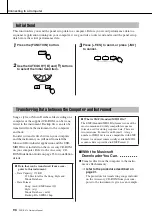
Style (Auto-accompaniment) Functions
PSR-E413 Owner’s Manual
77
The Dictionary function is essentially a built-in “chord book” that shows you the individual notes of chords.
It is ideal when you know the name of a certain chord and want to quickly learn how to play it.
1
Press and hold the LESSON [START]
button for longer than a second.
2
As an example, we’ll learn how to play a
GM7 (G major seventh) chord. Press the
“G” key in the section of the keyboard
labeled “ROOT”. (The note doesn’t
sound.) The root note you set is shown
in the display.
3
Press the “M7” (major seventh) key in
the section of the keyboard labeled
“CHORD TYPE”. (The note doesn’t
sound.) The notes you should play for
the specified chord (root note and
chord type) are shown in the display,
both as notation and in the keyboard
diagram.
To call up possible inversions of the chord,
press the [+]/[-] buttons.
4
Try playing a chord in the auto accom-
paniment section of the keyboard,
checking the indications in the display.
When you’ve played the chord properly,
a bell sound signals your success and
the chord name in the display flash.
Looking Up Chords Using the Chord Dictionary
Dict.
Hold for longer than
a second
001
Dict.
001
Dict.
Notation of chord
Chord name (root and type)
Individual notes of chord (keyboard)
• About major chords: Simple major chords are usually indicated only
by the root note. For example, “C” refers to C major. However, when
specifying major chords here, make sure to select “M” (major) after
pressing the root note.
NOTE
Содержание PSRE413 - KEYBOARD USB 100 PATTERNS
Страница 1: ...Owner s Manual DIGITAL KEYBOARD EN ...
Страница 101: ...Scores PSR E413 Owner s Manual 101 ...
Страница 103: ...Scores PSR E413 Owner s Manual 103 ...
Страница 105: ...Scores PSR E413 Owner s Manual 105 ...
















































